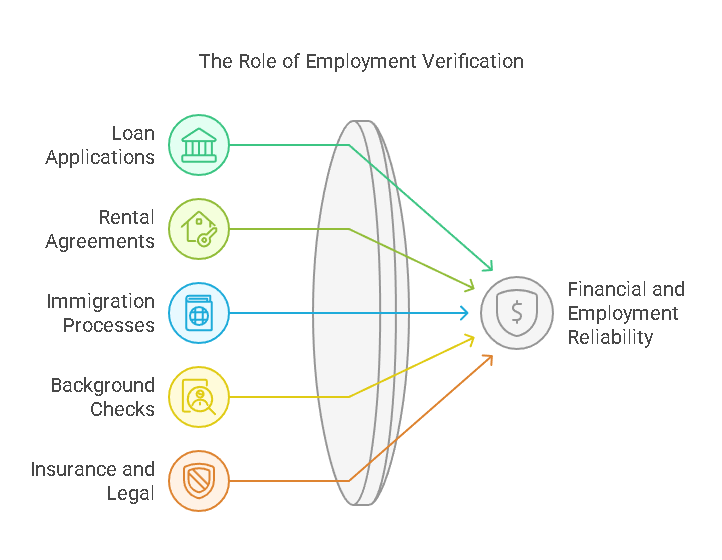The Complete Guide to Writing Employment Verification Letters and Salary Confirmation
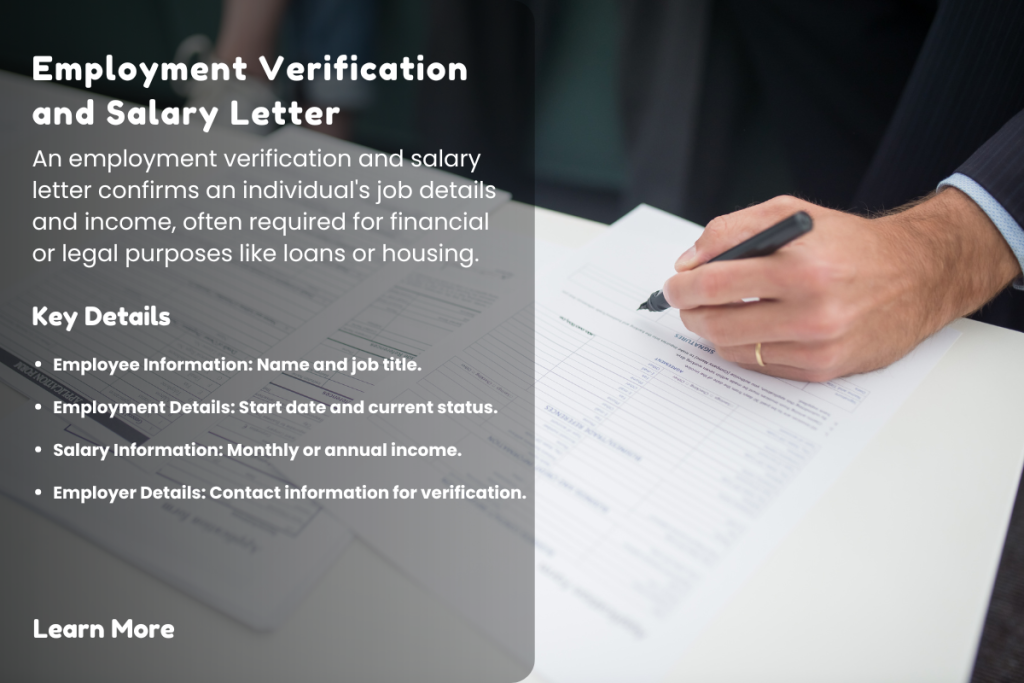
The Significance of Employment Verification Letters: A Comprehensive Overview
Employment verification letters are indispensable documents that play a pivotal role in modern professional and personal transactions. These letters, issued by an employer, serve as an official acknowledgment of an individual’s employment status, job role, and, often, their income details. They are frequently requested by third parties such as banks, landlords, government agencies, and potential employers to validate a person’s claims regarding their professional and financial standing.
While these letters might appear simple on the surface, their significance extends far beyond mere documentation. They are vital in fostering transparency, building trust, and facilitating seamless interactions between employees, employers, and other parties.
What Makes Employment Verification Letters Essential?
At their core, employment verification letters are tools of confirmation. Whether it’s a bank evaluating a loan application or a landlord assessing a potential tenant’s ability to pay rent, these letters provide the assurance needed to make informed decisions. They not only validate the details provided by the employee but also establish the credibility of the employer issuing the document.
For employees, these letters often act as gateways to achieving significant life goals, such as securing financial assistance, moving into a new home, or advancing their careers. For employers, issuing such letters reinforces their reputation as reliable and professional entities that value transparency. For third parties, they offer a layer of security, ensuring that decisions are based on accurate and verified information.
Real-Life Applications of Employment Verification Letters
The utility of employment verification letters spans across various domains. Below are some common scenarios where these documents are indispensable:
- Loan and Mortgage Applications
Financial institutions rely heavily on employment verification letters to assess a borrower’s financial stability. These letters provide crucial insights into the applicant’s salary, tenure, and job security, enabling lenders to calculate their repayment capacity. - Rental Agreements
Landlords often request employment verification letters to gauge a tenant’s ability to pay rent consistently. This is particularly common in competitive rental markets, where proving financial reliability can give applicants a significant edge. - Immigration and Visa Applications
Immigration authorities frequently require proof of stable employment and income as part of their evaluation process. Employment verification letters serve as tangible evidence of an applicant’s ability to support themselves financially in a new country. - Pre-Employment Background Checks
Employers conducting background checks on potential hires use employment verification letters to validate claims made on resumes. This step is crucial in maintaining the integrity of the hiring process. - Insurance and Legal Proceedings
In some cases, these letters are used during insurance claims or legal disputes to establish facts related to employment and income. They can be critical in determining the outcomes of such cases.
Elements of a Well-Structured Employment Verification Letter
A professionally crafted employment verification letter is not just about including basic information; it’s about presenting it in a manner that is both comprehensive and easy to understand. Below are the key elements that should be included in every employment verification letter:
- Employer Information: The name, address, and contact details of the organization issuing the letter. This establishes the authenticity of the document.
- Employee Details: Full name, job title, department, and dates of employment.
- Salary Information: Current salary or income, including any additional compensation such as bonuses or commissions, if applicable.
- Purpose Statement: A brief explanation of why the letter is being issued, tailored to the specific request.
- Authorized Signature: The signature, name, and designation of the person authorized to issue the letter, along with their contact details for verification purposes.
The inclusion of these elements ensures that the letter fulfills its purpose effectively, whether it’s for a loan application, rental agreement, or another use case.
How Employment Verification Letters Foster Trust and Transparency
The ability to validate information is a cornerstone of trust in professional and personal relationships. Employment verification letters serve this purpose by acting as a bridge of transparency between stakeholders. For employees, they are a testament to their stability and reliability. For employers, they demonstrate a commitment to supporting their workforce while adhering to professional standards. For third parties, these letters provide the confidence needed to proceed with transactions or agreements without unnecessary delays or concerns.
Consider the example of a bank assessing a home loan application. Without a formal employment verification letter, the lender would have no concrete basis for evaluating the applicant’s income or job security. By providing a detailed letter, the employer not only assists the employee in achieving their goal but also reinforces their credibility as a reliable institution.
Practical Tips for Requesting and Issuing Employment Verification Letters
For Employees:
When requesting an employment verification letter, it’s essential to be clear about the purpose. This helps the employer tailor the content to meet the specific requirements of the requestor. For instance, a letter for a mortgage application may need to include detailed income information, while one for a rental application might focus on job stability.
For Employers:
Employers should ensure that every letter issued is accurate and professional. Using official letterhead and adhering to a standardized format can enhance the credibility of the document. It’s also crucial to respond to requests promptly, as delays could impact the employee’s ability to achieve their objectives.
Why Accuracy Matters in Employment Verification Letters
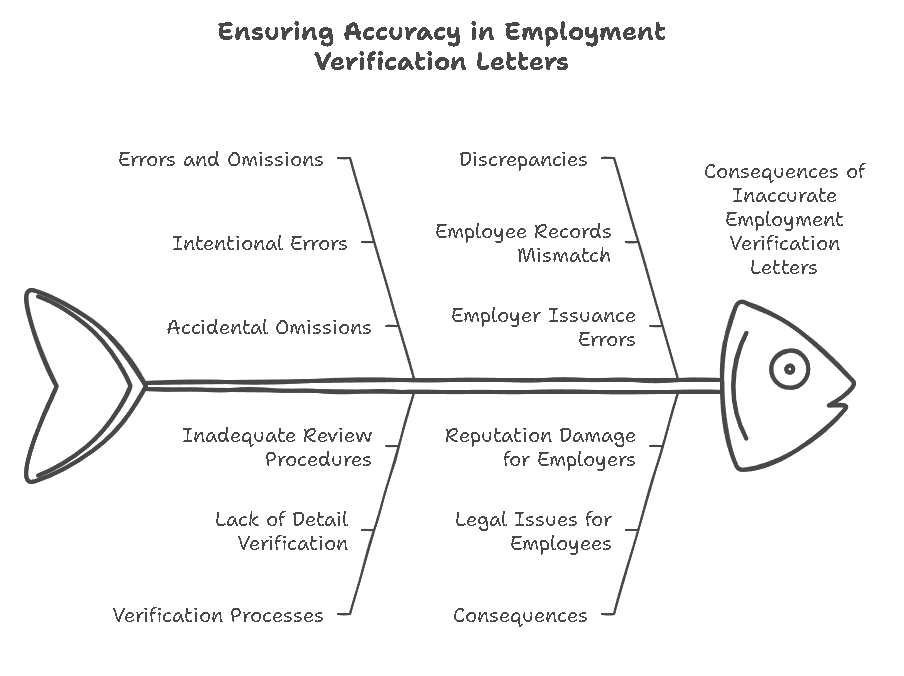
The accuracy of employment verification letters cannot be overstated. Errors or omissions, whether intentional or accidental, can lead to serious consequences. For employees, inaccurate information could result in denied applications or even legal issues. For employers, issuing incorrect letters can harm their reputation and potentially expose them to liability.
Ensuring accuracy requires a thorough review process. Employers should verify all details before issuing the letter, and employees should double-check the document to confirm that it aligns with their records. In cases of discrepancies, immediate corrections should be made to avoid complications.
Employment Verification Letters in a Global Context
In today’s interconnected world, employment verification letters are increasingly being used across international borders. This is particularly true for individuals seeking employment or residency in a foreign country. Employers issuing these letters must ensure they comply with the requirements of the target country, such as including specific information or using a particular format.
For example, a work visa application in Canada may require details about the employee’s job responsibilities and salary, while a similar application in the UAE might focus more on job title and tenure. Understanding these nuances is essential for employers who wish to support their employees effectively.
How to Create a Sample Letter of Employment Verification and Salary
Creating an effective employment verification letter requires attention to detail, a clear understanding of the purpose of the letter, and the appropriate structure to meet the needs of the requestor. Whether it’s for a mortgage, rental application, background check, or government compliance, the format and content of the letter must be both professional and accurate.
In this section, we will break down the process of crafting an effective employment verification letter and offer different examples to cover a variety of scenarios. Additionally, we will share tips on how to ensure that the letter complies with industry standards and best practices.
Step-by-Step Guide to Writing an Employment Verification Letter
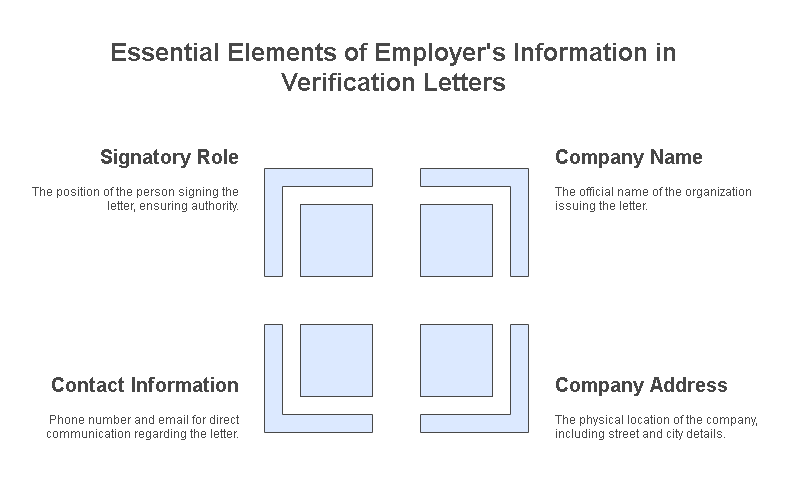
To ensure the letter is both effective and professional, follow these steps:
1. Start with the Employer’s Information
The letter should begin by clearly stating the employer’s details. This includes the name of the company, its address, and the contact information of the person issuing the letter. Typically, the letter is signed by someone in a management or human resources position, such as an HR manager, supervisor, or director. Here’s how to structure this part:
Example:
[Company Name]
[Company Address]
[City, State, Zip Code]
[Phone Number]
[Email Address]
This section is crucial because it authenticates the letter and provides a point of contact for verification.
2. Employee’s Information
Next, include the employee’s full name, job title, department, and employment dates (start and, if applicable, end date). If the employee has held different positions, outline their job history with your organization.
Example:
Employee Name: [First Name, Last Name]
Job Title: [Current Job Title]
Department: [Department Name]
Employment Dates: [Start Date] – [Present or End Date]
This part helps confirm the employee’s identity and job status.
3. Salary Information
The letter should outline the employee’s salary or wages. For salaried employees, this section would mention their annual or monthly salary. For hourly employees, the hourly rate and average number of hours worked per week may be included.
It is essential to be clear and precise in stating the salary or wage details to avoid ambiguity. If bonuses, commissions, or other forms of compensation are part of the employee’s package, they should be clearly mentioned as well.
Example:
Salary: [Annual Salary/Hourly Rate]
Additional Compensation: [Bonuses, Overtime, Commissions]
4. Purpose of the Letter
The purpose of the letter should be stated to ensure clarity. This could be for loan approval, rental application, immigration purposes, or employment verification for another company. Tailoring the purpose helps avoid confusion and makes the letter relevant to the request.
Example:
The purpose of this letter is to verify [Employee’s Name]’s employment and salary information for a [Loan Application, Rental Application, Immigration Purpose, etc.].
5. Closing with Authorized Signature
Conclude the letter with a closing statement and the signature of the authorized individual issuing the letter. The contact details of the signer should also be provided in case the recipient has further questions. This is the final confirmation that the letter’s contents are accurate and legitimate.
Example:
Sincerely,
[Name of Authorized Signer]
[Job Title]
[Company Name]
[Contact Information]
Types of Employment Verification Letters
There are several scenarios in which an employment verification letter might be required. Each scenario has its specific requirements in terms of what information needs to be included. Below, we provide examples for various types of letters:
1. Loan Application Verification
When applying for a loan, whether it’s for a car, home, or personal loan, lenders require proof of steady income and employment history. Here’s what this letter should include:
- Employee’s full name and job title
- Date of employment and current salary
- Additional financial details like bonuses or overtime (if applicable)
- Purpose statement: “This letter is provided for the purpose of verifying employment for a loan application.”
Example:
[Employer’s Information]
[Employee’s Full Name] has been employed with [Company Name] since [Start Date]. [He/She] is currently working as a [Job Title] in the [Department Name]. [Employee’s Full Name] earns an annual salary of [Salary Amount] with additional compensation of [Bonus, Overtime, etc.]. This letter is issued to verify [Employee’s Name]’s employment and income for a loan application.
2. Rental Application Verification
When an employee is renting a home or apartment, landlords often request an employment verification letter to ensure that the tenant has a stable income. Key information to include:
- Job title, start date, and salary information
- Length of employment and job stability
- Purpose statement: “This letter serves as verification of employment for a rental application.”
Example:
[Employer’s Information]
[Employee’s Full Name] has been employed with [Company Name] as a [Job Title] since [Start Date]. [He/She] currently earns a salary of [Salary Amount] per year. This letter is being issued to verify [Employee’s Full Name]’s employment and income for a rental application.
3. Immigration or Visa Application Verification
For individuals applying for a visa or immigration purposes, the letter should focus on proving financial stability and employment security. Information to include:
- Job title, department, and employment history
- Annual income, bonuses, and other financial details
- Purpose statement: “This letter is provided to verify employment for visa or immigration purposes.”
Example:
[Employer’s Information]
[Employee’s Full Name] has been employed with [Company Name] as a [Job Title] since [Start Date]. [His/Her] current annual salary is [Salary Amount], and [he/she] has received a [Bonus/Other Compensation] of [Amount]. This letter is issued to verify [Employee’s Name]’s employment for immigration purposes.
Tips for Ensuring a Professional and Compliant Employment Verification Letter
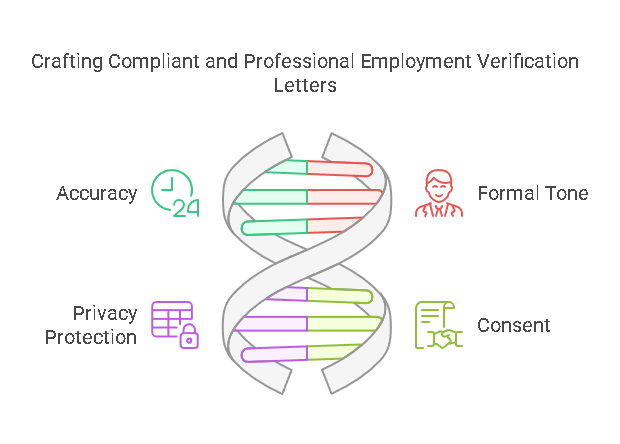
Creating an employment verification letter requires more than just filling in blank spaces. It’s essential to adhere to professional standards and ensure compliance with legal requirements. Here are some tips to help make sure your letter meets these criteria:
- Be Accurate: Accuracy is paramount in an employment verification letter. Ensure that all details, especially salary and job title, are correct.
- Keep It Formal: The letter should maintain a professional tone throughout. Avoid informal language and ensure that the content is objective and factual.
- Limit Personal Information: To protect the employee’s privacy, avoid including unnecessary personal information, such as marital status or health details, unless specifically required.
- Obtain Consent: Ensure that the employee has given consent for their employment information to be disclosed. In some jurisdictions, failure to obtain consent can lead to privacy violations.
PreciseHire: Your Partner in Employment Verification
When it comes to employment verification and background checks, PreciseHire provides comprehensive services to streamline the process. We specialize in conducting thorough employment screenings that help employers make informed hiring decisions. Our services ensure that the employment details provided are accurate, complete, and compliant with industry regulations. Whether you’re conducting pre-employment screenings or verifying current employees for loans or rental purposes, PreciseHire offers fast, reliable, and confidential verification services.
Types of Employment Verification Letters Comparison
Below is a comparison table to summarize the key differences between the various types of employment verification letters:
| Type of Letter | Key Components | Purpose |
|---|---|---|
| Loan Application Verification | Employee’s name, job title, salary, employment dates | To verify income and employment for loan approval |
| Rental Application Verification | Job title, start date, salary, employment stability | To confirm the tenant’s ability to pay rent consistently |
| Visa/Immigration Verification | Job title, salary, employment history, bonuses, commissions | To verify employment and income as part of a visa or immigration process |
| Background Check Verification | Job title, employment dates, salary information | To validate employment history during a background screening process |
Legal Aspects, FAQs, and Conclusion
Employment verification letters are not only crucial documents for validating employment status and income, but they are also subject to various legal regulations and guidelines. It is essential for both employers and employees to understand these legal aspects to ensure compliance, avoid potential legal issues, and protect privacy. In this section, we will explore the key legal considerations related to employment verification letters, answer some of the most frequently asked questions (FAQs), and conclude the discussion on best practices for creating and using these important documents.
Legal Considerations for Employment Verification Letters
When issuing or requesting an employment verification letter, there are several important legal factors to consider. These ensure the letter is compliant with privacy laws, regulations, and professional standards.
1. Confidentiality and Privacy
One of the most critical legal aspects of employment verification letters is confidentiality. Employers are responsible for safeguarding personal and sensitive information about their employees. An employment verification letter should include only the relevant details—such as employment status, job title, salary, and dates of employment—and should avoid sharing unnecessary personal information.
In many jurisdictions, laws such as the General Data Protection Regulation (GDPR) in the EU or the California Consumer Privacy Act (CCPA) in the United States mandate that employers obtain the consent of employees before disclosing their personal data to third parties. The employee’s consent should be clearly obtained in writing before issuing any employment verification letter.
2. Consent to Share Employment Information
In most cases, an employer cannot disclose an employee’s employment details without the employee’s consent. This includes not only salary information but also any other personally identifiable details. While a general consent form might be signed by employees during the hiring process, employers should ensure they obtain explicit permission before releasing any additional information to third parties.
For instance, if an employee requests an employment verification letter for a bank loan, they should sign a consent form acknowledging that their salary, job title, and employment history can be shared with the financial institution. Failure to obtain consent could result in legal challenges under privacy laws.
3. Accuracy and Legality of Information
Employers are legally obligated to ensure the accuracy of the information provided in an employment verification letter. Falsifying or providing inaccurate details—whether intentional or unintentional—can expose the employer to legal liability. For instance, if an employer mistakenly states that an employee has worked at the company for a longer period than they actually have, the employee could face significant issues, such as being denied a loan or rental application.
Furthermore, providing inaccurate salary information can lead to financial complications or breaches of contract. Employees who are denied loans or fail to secure rental agreements due to incorrect information could pursue legal action for damages.
4. Employment Verification and Anti-Discrimination Laws
Employers must also be mindful of anti-discrimination laws when issuing employment verification letters. These laws prohibit the discrimination of employees based on factors such as race, gender, age, religion, or disability. The information provided in an employment verification letter should remain neutral and professional, ensuring that no details are included that could potentially reveal sensitive personal characteristics.
For example, an employer should not include information about an employee’s marital status, health status, or personal beliefs in an employment verification letter unless it directly relates to the purpose of the letter (e.g., visa applications, which may require family information in some countries).
5. Retention of Employment Records
Employers should be aware of the legal requirements surrounding the retention of employee records. In many countries, there are specific guidelines on how long employment records must be kept, and this may vary depending on the type of information involved. For example, in the U.S., the Fair Labor Standards Act (FLSA) mandates that records related to employee compensation must be retained for a minimum of three years. It is essential for employers to follow these guidelines when issuing employment verification letters to ensure that they are in compliance with the law.
Frequently Asked Questions (FAQs) about Employment Verification Letters
What is the difference between employment verification and background screening?
Employment verification is the process of confirming an employee’s job title, employment dates, and salary details. It’s typically requested by a third party (e.g., a bank or landlord) to validate employment and income information. On the other hand, background screening involves a more comprehensive check that includes criminal history, credit reports, educational verification, and other background information. While employment verification is part of the background screening process, it is just one of many components.
How long does it take to get an employment verification letter?
The time it takes to receive an employment verification letter can vary depending on the employer's internal processes. Typically, it can take anywhere from a few days to a week. Some employers may have standard templates for these letters, making the process quicker, while others may need additional time to gather the necessary information and obtain approval. To expedite the process, employees should make their requests well in advance and provide clear instructions regarding the purpose of the letter.
Are employers legally obligated to provide employment verification letters?
In most cases, employers are not legally required to provide employment verification letters unless stipulated by a contractual obligation or a specific law. However, employers are generally encouraged to assist employees by verifying their employment details when requested. Many employers have internal policies that require them to provide such letters as a standard service to employees.
Can employment verification letters be used for multiple purposes?
Yes, employment verification letters can often be used for multiple purposes. For example, an employee might use the same verification letter to apply for a loan, secure a rental property, or confirm employment for a government visa. However, the purpose of the letter should be clearly stated to ensure that the information provided is suitable for the specific requirement.
What should I do if my employer refuses to provide an employment verification letter?
If an employer refuses to provide an employment verification letter, employees can try the following steps:
- Request in Writing: Sometimes, formalizing the request in writing can help.
- Check Company Policy: Review the employer’s internal policies regarding verification requests. Some companies have strict protocols or may only issue letters under specific conditions.
- Seek Alternative Solutions: If the employer still refuses, employees may provide pay stubs, tax forms, or other proof of employment as alternatives.
Conclusion
Employment verification letters are crucial documents that serve as a verification of an employee’s job status and salary. While creating these letters is a straightforward task, it involves legal considerations such as confidentiality, accuracy, and obtaining consent. Employers must be diligent in ensuring that the information provided is correct, and that it complies with relevant privacy laws and regulations.
For employees, understanding the purpose and requirements of these letters is equally important. Whether seeking a loan, applying for a rental property, or going through a background check, knowing how to request a well-written, accurate verification letter can make all the difference.
By following best practices, such as obtaining written consent, keeping the information relevant and concise, and complying with legal obligations, both employers and employees can benefit from the effective use of employment verification letters.
For employers looking to streamline the process of background checks, employment screenings, and verification services, PreciseHire offers comprehensive solutions that ensure accurate and compliant documentation. With our support, organizations can ensure that employment verification is done professionally, efficiently, and within legal bounds.

